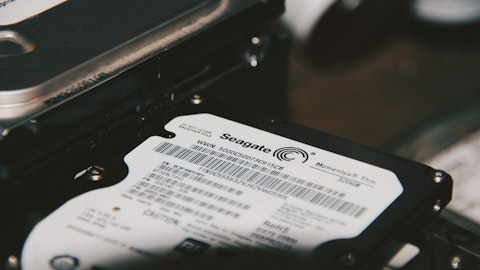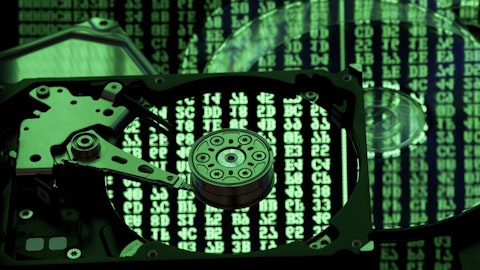Aaron Rakers : Yes, two if I can as well. I guess the first question, you mentioned, obviously, in the numbers that you’re shipping about 30% below what was the peak level seen a year or so ago. As we think about the efforts that you’ve made on rationalizing your production capacity, is there any way to gauge how we could think about what kind of fully utilization looks like on an exabyte ship basis as we move forward? Just trying to think about the trajectory based on that number relative to gross margin? What’s kind of the capacity footprint that you guys have normalized to now?
Dave Mosley: Yes. Hi, Aaron, I think there’s a couple of different answers to that question. Obviously, from an equipment perspective, all the equipment is still there. As a matter of fact, as we go through transitions to say, 2.2 terabyte per disk or 2.4 terawatt per disk to a 3 terabyte per disk, we get a lot more efficient out of our parts that we have accessible to us and out of that same equipment, some penalties with process content. But generally speaking, our capacity footprint goes up. In the current — to directly answer your question in the current state, we did have to scale back in our factories, and that will take just a little bit of time, not a lot of time to scale back up because that’s about people. It’s been a tremendously painful time for our people, for the people in the supply chain for the people and the customers for that matter.
So I would say that our theoretical capacity is still as high as it is, but we can’t react on a dime to go get there. We need to plan for it. And once upon a time, we did 165 exabytes. We could get back there fairly with all the technology transitions, we can also go beyond.
Aaron Rakers : Yes, yes. That’s helpful. And then as a quick follow-up. I think last quarter with the headcount reduction effort, you had talked about I think it was getting to realizing the annualized expense savings of about $110 million starting in this current quarter. How do we think about the effect of that on a net basis in this current fiscal quarter?
Gianluca Romano : Yes. We realized a big part of that saving already starting in the December quarter, as we were discussing beginning of November. The majority of our restructuring actually happened at the beginning of November. So we had basically two full months out of the three where we could take the benefit of the cost reduction. And now in OpEx, there are always few other items that impact the cost of the quarter. In the script, I said we expect this quarter and even next quarter to still be around the $300 million.
Operator: And our next question will come from Timothy Arcuri with UBS.
Jason Park: This is Jason on for Tim from UBS. I have a couple of questions. So the first question is on December quarter. Sorry if I missed, but I see that there’s about $100 million purchase order cancellation fees in December quarter. Could you guys help us understand what that line item really is? And also, would there be any possibility of this repeating in a similar magnitude next couple of quarters if demand remains weak? And I have a follow-up.
Gianluca Romano : Yes. That is really through our reduction in production. Of course, we had some commitment with some of our suppliers that, of course, we want to comply with. So on those cases, we had to stay for take-or-pay products that we didn’t need, and we decided not to take based on our focus on reducing our own inventory on top of reducing customer inventory. I think we have taken all those liabilities into the December quarter. So I don’t expect at this point this those liabilities to come back in the March quarter.
Jason Park: Got it. Yes. My second question is on your debt paydown schedule and cash level. So on the back of your recent debt exchange, how are you guys thinking about the pace and magnitude of debt pay down in the next few quarters? And in light of that, how can we think about the new cash level you guys are comfortable operating under going forward?
Gianluca Romano : Yes, we are generating still a fairly strong free cash flow. In the December quarter, we generated $170 million, I think this quarter will be higher than that. We have note that will mature at the beginning of June that we want to repay and we will not refinance, that is about $540 million. So we will use our cash. We have actions going on to optimize our cash between now and June. But I would say, right now, our focus is actually on reducing the debt and reducing the full amount of those notes.
Operator: And our next question will come from Sidney Ho with Deutsche Bank.
Sidney Ho : Congrats on pulling in the launch schedule of HAMR drives. A couple of questions here. How are you thinking about the adoption of HAMR drives in the back half of the year into ’24? Is it more broad-based? Or is it focused on a few customers — and I know it’s early, but do you expect — when do you expect unit or exabyte crossover for HAMR drives? And lastly, on this subject, just to be clear, are you planning to dual track with PMR products in the 30-terabyte range? And then I have a follow-up question.
Dave Mosley: I appreciate all the positive momentum that’s going on. It really — there’s a lot of people inside of our company and outside of our company that deserve accolades here making this technology work believed in it for the last 20 years and so on. And I think it’s great that the world is going to be able to double nasty points and things like that over time. I’ve got a lot of confidence based on where we sit right now. We’re not talking about exactly what the schedule is going to be, but we’re going to be as aggressive as we possibly can. Specifically to your question, yes, I think the first drives will probably go out into a couple of different channels, some we can control like we’ve talked about maybe using our systems business in the prepared remarks.
And then some big customers are — want to be early adopters so that they understand the technology and what to take. It’s I would say at the highest capacity point, the integration always the trickiest because these are things that the world has never seen before. To the extent we can turn around and make cheaper capacity points that are midrange like 20 or 16 or whatever they happen to be because we have fewer heads and disks in them. That’s a great answer for us as well, and we’ll get working on that. So I don’t think the once we get out the heads and disks, I think we’ll be able to find homes for them, and we’re going to be very, very aggressive on the ramp over the next few years.
Sidney Ho : Okay. Maybe a follow-up question. You and your competitors have both in quite in terms of production cost in this down cycle. Curious if you’re seeing any less rational behavior in terms of pricing given the high level of inventory in the channel and the customers in the December quarter, but more importantly, going forward, do you think the pricing environment will still be okay?
Dave Mosley: Yes, I do think the way to control the long-term outcome, the best is to cut your production and make sure you’re not pushing out too much of the wrong stuff. I’m encouraged to see the way that the industry is actually behaving on that front. I don’t — to your point, I don’t look at things like market share and any individual deals as long-term trends at this point in time. I think it’s more just what discipline does the industry have. And I do think that over the long haul, especially for Seagate, I can speak, having the ability to go add a better value proposition, lower our costs and so on and so forth. I think we use that to think about how do we get back into our margin range or beyond.
Operator: And our next question will come from Vijay Rakesh with Mizuho.





